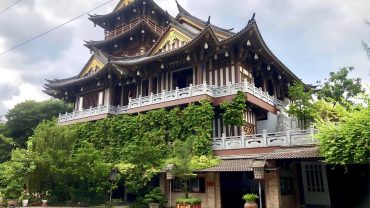Are you passionate about Vietnamese traditional culture? Would you like to explore renowned craft villages known for their unique and beautiful products? Join BDATrip as we take you on a journey to discover the fascinating charms of Bat Trang Ceramic Village and Duong Lam Ancient Village in this article!
## Bat Trang Ceramic Village
### History of Bat Trang Ceramic Village
Bat Trang, Vietnam’s oldest and most renowned pottery village, sits along the banks of the Red River in Bat Trang commune, Gia Lam district, Hanoi. The village traces its origins back to the reign of King Ly Thai To, when he moved the capital to Thang Long (modern-day Hanoi). Artisans from Bo Bat village (Ninh Binh) followed the king and settled here, drawn by the area’s rich deposits of white clay, ideal for creating exquisite pottery. By the 15th century, Bat Trang pottery had gained national recognition and was even exported abroad. The village’s products became so valued that they were chosen as tribute to the Ming dynasty by the royal court.
The name “Bat Trang” translates to “the big yard,” reflecting the expansive space dedicated to pottery production. It also symbolizes the village’s prosperity and heritage, serving as a reminder for future generations to uphold the traditions and values passed down by their ancestors. Bat Trang pottery village has endured for centuries, weathering numerous historical events while preserving its unique cultural and artistic identity. The village’s pottery not only boasts high aesthetic value but also reflects the soul, daily life, and national pride of the Vietnamese people. Bat Trang’s products are diverse in shape, color, pattern, and style, ranging from everyday items like bowls, plates, pots, cups, and vases to decorative pieces such as paintings, statues, and intricate designs, as well as ceremonial objects like incense burners and bowls.
[image-1|bat-trang-ceramic-products|Bat Trang ceramic products display|A wide variety of Bat Trang ceramic products are displayed on shelves and stands, showcasing the village’s craftsmanship and artistry in pottery.]
**Traditional Crafts of Bat Trang Ceramic Village**
Bat Trang Ceramic Village is renowned for its traditional pottery techniques, which have been meticulously passed down through generations. The creation of Bat Trang pottery involves a blend of skill, sophistication, and creativity:
* **Shaping Pottery:** This initial stage involves forming pottery from white clay using a spinning wheel. Artisans mold the clay into various shapes, and the pieces are then left to dry and harden.
* **Decorating Patterns:** At this stage, artisans adorn the pottery with intricate patterns. They apply different glazes to create vibrant colors and effects. The designs often draw inspiration from nature, culture, history, and spirituality of the Vietnamese people.
* **Firing Pottery:** The final stage involves placing the pottery in a kiln where it is subjected to high temperatures. This process melts the glaze and ensures it adheres to the pottery’s surface. Once fired, the pottery is cooled, with the firing process crucial to determining the quality and durability of the final product.
**Tourism Activities in Bat Trang Ceramic Village**
A visit to Bat Trang Ceramic Village offers not only the chance to admire exquisite pottery but also to engage in several enriching and enjoyable activities:
* **Explore Van Van Ancient House:** This historic residence, dating back to the 18th century, exemplifies traditional Vietnamese countryside architecture. Covering approximately 3,000 square meters, it consists of five interconnected houses with 19 rooms. The house is adorned with antique items and pottery from Bat Trang, offering a glimpse into the village’s rich heritage.
* **Try Pottery Making:** One of the most engaging activities in Bat Trang is creating your own pottery. Whether it’s bowls, plates, pots, cups, or decorative pieces like paintings and statues, you can craft your own designs under the guidance of skilled artisans. You’ll use tools such as a spinning wheel and pottery knife, and after completing your piece, you can take it home as a unique souvenir.
* **Shop for Pottery:** Bat Trang is home to numerous shops and markets where you can purchase a wide array of pottery items. From simple, affordable pieces to high-end, intricate designs, there’s something for every taste and budget. Don’t forget to haggle for the best price on your favorite pieces!
[image-2|bat-trang-pottery-workshop|Tourists trying pottery making in Bat Trang|Inside a Bat Trang pottery workshop, tourists are getting their hands dirty learning how to make pottery. They sit at spinning wheels, shaping clay under the guidance of skilled local artisans.]
## Duong Lam Ancient Village
**History of Duong Lam Ancient Village**
Duong Lam, an ancient village with origins dating back to the reign of the 18th Hung King (around 2,500 years ago), is located in Son Dong commune, Son Tay district, Hanoi. The village is often referred to as the “hometown of two kings”—Ly Thai To and Ngo Quyen—both of whom played pivotal roles in Vietnamese history. Ly Thai To founded the Ly dynasty in the 11th century, while Ngo Quyen led the defeat of the Southern Han army in the 10th century, restoring Vietnam’s independence.
Duong Lam Ancient Village covers an area of approximately 103 hectares and is comprised of nine hamlets: Mong Phu, Dong Sang, Cam Thinh, Do Doc, Phu Khanh, Phung Hung, Tan Thinh, Van Mon, and Ngo Quyen. The village is nestled amidst rivers and ponds, creating a tranquil and picturesque setting. Duong Lam is often regarded as a living museum of traditional Vietnamese architecture. The houses, constructed from ancient ironwood and blue stone, feature red-tiled roofs and a distinctive three-room, two-wing design. Interiors are adorned with antique items like copper wall paintings, ebony furniture, and lotus vases. These homes are enclosed by blue stone fences and traditional wooden village gates, preserving the village’s timeless charm.
This is also a place that preserves many important historical and cultural relics. The prominent relics are: The temple of two kings Ly Thai To and Ngo Quyen, Phuc Lam pagoda, Mia pagoda, Nom pagoda, Mong Phu communal house, Dong Sang communal house, Cam Thinh communal house, Do Doc communal house… These relics not only have architectural value but also have spiritual and religious significance for the people here.
### Tourism activities in Duong Lam Ancient Village
Duong Lam, an ancient village in Hanoi’s Son Tay district, is a charming tourist destination celebrated for its rich history, cultural heritage, and traditional Vietnamese architecture. Visitors can explore the village’s historic landmarks, enjoy authentic local cuisine, and participate in cultural and farming activities that provide a deeper understanding of traditional Vietnamese life.
A highlight for visitors to Duong Lam Village is its unique and flavorful local cuisine. Among the must-try dishes is banh te, a small, round sticky rice cake filled with green beans or pork fat, boiled and paired with sesame salt. Another local specialty is sugarcane wine, made from fermented sugarcane juice, offering a sweet yet slightly spicy taste. You can also indulge in traditional treats like che lam (a chewy rice cake), sweet potato pudding, sweet potato cake, and various rice cakes. These delicacies can be easily found at restaurants and eateries throughout the village.
[image-3|duong-lam-ancient-village-street|Peaceful street in Duong Lam ancient village|A serene street in Duong Lam ancient village, lined with traditional Vietnamese houses built with laterite bricks, red tile roofs, and adorned with beautiful bougainvillea flowers.]
If you’re a culture enthusiast, Duong Lam Ancient Village offers an array of captivating and unique cultural experiences. You can enjoy traditional water puppetry, a classic Vietnamese art where wooden puppets are masterfully controlled on the water’s surface. Immerse yourself in the melodies of cheo and quan ho singing, two forms of ca tru, performed by male and female vocalists using folk songs. Additionally, take part in traditional folk games like tug-of-war, shuttlecock kicking, and blindfolded goat catching, allowing you to experience the joyful spirit and hospitality of the local community.
In addition, you can immerse yourself in the daily life of Duong Lam’s rural community by taking part in farming activities. Try your hand at plowing fields, sowing seeds, harvesting rice, picking fruits, and even milking cows, gaining firsthand insight into the hardworking lives of local farmers. As you engage in these tasks, you’ll also enjoy the fresh, serene atmosphere of the countryside, experiencing a slower pace of life and a deeper connection to the land.
## Travel tips for Bat Trang & Duong Lam Village
To ensure a successful and complete trip to Bat Trang Ceramic Village and Duong Lam Ancient Village, here are a few important tips:
* **Travel time:** You can visit Bat Trang and Duong Lam year-round, but for the best experience, plan your trip in spring (January-March) or autumn (September-November) when the weather is cool and dry.
* **Transportation:** There are several ways to reach Bat Trang and Duong Lam. From Hanoi, you can travel by bus, coach, motorbike, or car. If you’re coming from other provinces, you can take a plane, train, or coach to Hanoi, then transfer to Bat Trang and Duong Lam.
* **Travel cost:** Visiting Bat Trang and Duong Lam is affordable. To save on expenses, consider booking a tour from Hanoi, which can help cover transportation, meals, entrance fees to historical sites, and shopping, all in a balanced package.
* **Eating and accommodation:** Both villages offer a variety of restaurants and eateries where you can enjoy local specialties. For an authentic experience, you can stay overnight at homestays or hotels, soaking in the peaceful and cozy atmosphere of the countryside.
Vietnamese traditional villages are captivating and worthwhile destinations for those eager to explore the country’s rich culture and history. Whether you join a tour or venture out on your own, you’ll have the chance to meet and converse with local people, savor home-cooked meals, and take part in traditional activities, gaining a deeper appreciation for Vietnam’s unique heritage.
Traveling to Bat Trang and Duong Lam Village is an excellent choice for those looking to explore the rich cultural and historical heritage of Vietnam.




Comment (0)